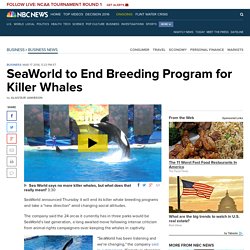

Facilities with captive Orcas. Killer [Whale] Acoustics. Vocal learning has been a subject of research in the fields of acoustics and social science for many years.
![Killer [Whale] Acoustics](http://cdn.pearltrees.com/s/pic/th/killer-whale-acoustics-131320005)
Over time, findings have proven positive in some types of birds, bats, and cetaceans including whales and dolphins. Research by avian scientists has identified specific neural pathways in the brains of songbirds, allowing for a scientific explanation for the ability of adaptation, but until now, information on larger marine mammals has been difficult to obtain.
Killer whales communicate similarly to humans in that they form distinct patterns of dialect within their specific social groups. Repeated patterns of sound using complex vocal clicks, whistles, and pulsed sounds in variations of pitch, duration, and pulse vary depending on the social community the whale has been exposed to. Findings in this study helped explain the high level of adaptation of killer whales and their motivation to match their social environment. Photo: treehugger, source: ScienceDaily. Amazing Facts About Killer Whales. Orcas: Facts About Killer Whales. Orcas are often called killer whales.

Though they don't typically attack humans, this name is still well-chosen due to the animal's ability to take down large marine animals, such as sea lions and whales. In fact, orcas will prey on almost any animal they find in the sea, in the air over the water or along the coastline. To hunt, killer whales use their massive teeth, which can grow up to 4 inches (10 centimeters) long. Size Orcas are known for their long dorsal fin (the fin on the animal's back) and black-and-white coloring.
According to National Geographic, orcas are considered the largest species of the dolphin family. Habitat Killer whales are the most widely distributed mammals, other than humans, according to Sea World. These animals do not stay in one area and have been documented traveling long distances. Habits Orcas are very social and live in groups called pods, which usually have up to 40 members, according to National Geographic. Diet Offspring Classification/taxonomy Other facts. 10 Things You Didn't Know About SeaWorld. 1.

Their Sunburns Are Covered Up With Black Zinc Oxide Orcas at SeaWorld spend most of their time floating listlessly at the surface of the water with little to no shade from the hot blistering sun. In the wild, orcas spend up to 95 percent of their time submerged and would find shade in the depths of the ocean, but at SeaWorld their tanks are far too shallow.
Their deepest tank is 40 feet deep—not nearly deep enough to give them a reprieve from the harsh elements. Because of this, orcas have perpetual sunburns, which are shielded from the public eye with the help of black zinc oxide, which matches their skin. 2. Five orcas currently at SeaWorld were kidnapped from their ocean homes, as were others who have since died. 3. In 1965, the first-ever orca show at SeaWorld was performed by a female orca named Shamu at SeaWorld San Diego. 4. SeaWorld to End Breeding Program for Killer Whales. SeaWorld announced Thursday it will end its killer whale breeding programs and take a "new direction" amid changing social attitudes.

The company said the 24 orcas it currently has in three parks would be SeaWorld's last generation, a long awaited move following intense criticism from animal-rights campaigners over keeping the whales in captivity. "SeaWorld has been listening and we're changing," the company said in a statement. "Society is changing and we're changing with it.
SeaWorld is finding new ways to continue to deliver on our purpose to inspire all our guests to take action to protect wild animals and wild places. " Joel Manby, president and CEO of SeaWorld, wrote in an op-ed article in the Los Angeles Times that its existing whales would remain in captivity because setting them free in the wild was "not a wise option. " "Most of our orcas were born at SeaWorld, and those that were born in the wild have been in our parks for the majority of their lives," he wrote. Opinion: SeaWorld vs. the Whale That Killed Its Trainer. Watch the television premiere of "Blackfish," Thursday, October 24, at 9 p.m.

EST on CNN. The documentary Blackfish opened around the country on July 26, with more splash than usual for a small-budget production, thanks to a preemptive attack on the film by SeaWorld, the marine-park franchise, and the free publicity of the tempest that followed. Blackfish tells the story of Tilikum, the homicidal killer whale, and his most recent victim, Dawn Brancheau, the SeaWorld trainer he crushed, dismembered, and partially swallowed in 2010.
The film is an indictment of SeaWorld, its safety practices, its animal husbandry, its mendacity, and its whole reason for being. In the week before advance screenings in Los Angeles and New York, SeaWorld sent out a "Dear Film Critic" letter that castigated the documentary as "shamefully dishonest, deliberately misleading, and scientifically inaccurate. " Here's one: Tilikum had a sort of twin, Keiko, the killer whale who played "Willy" in the movies.